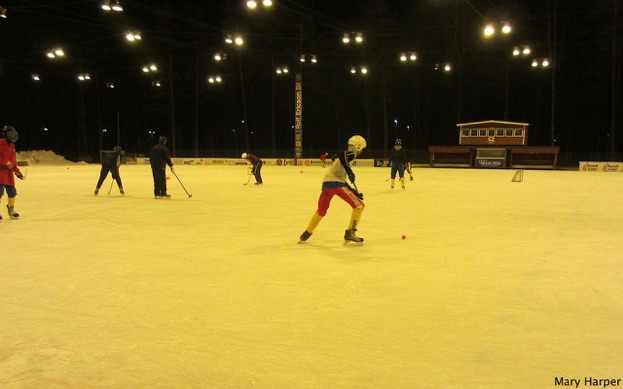MARY HARPER
(CUE: A team from the Horn of Africa is on its way to icy Siberia to take part, for the very first time, in the bandy World Championships. Bandy, for the uninitiated, is a bit like ice hockey. Only it's played with a ball rather than a puck. And, up to now, the teams playing it were mainly from northern hemisphere nations like Russia, Norway and Finland. Later this month, though, in the city of Irkutsk, a team from Somalia is taking part. These are Somalis who've recently gone to live in Sweden and Mary Harper's been there to talk to them and watch them prepare for the Championships.)
There, stretching out in front of me is a giant, smooth sheet of ice. It's the size and shape of a football pitch, with a little net goal at either end.
It's night-time and the sky is pitch black. Lit by floodlights, the perfect white of the ice seems to glow from the inside. It's still and quiet. Around the pitch, I can just make out tall pine trees standing like silent guards.
Suddenly the peace is broken.
Figures in bright colours swarm onto the ice. I hear the whoosh and scrape of skates. The thwack of wooden sticks hitting a ball. The occasional thump of a body coming down hard.
The voice of the coach travels loud and clear through the night air. And it's then I notice something strange. We may be in a small Swedish town, playing a very Swedish game. But the coach is the only white face on the pitch.
Everyone else is black. And they're speaking a language I recognise. Somali.
This is the Somali National Bandy Team, and its headquarters is right here in the Swedish town of Borlenge.
Ahmed Hussein is a member of the team. He's wearing a big red top that billows around his slight frame. He has an impossibly engaging smile, with deep dimples in his cheeks. "I grew up in Mogadishu," he says, "where the only thing I knew about ice was as something to put in my Coca Cola".
Ahmed tells me that a few months ago, not a single member of the team knew how to skate, let alone play bandy. How a man called Patrick came to him and a group of friends and told them about this weird game.
Patrick is standing on the sidelines. "I was worried about the segregation of the Somalis and Swedes in my town," he says. "There were riots a few months ago in the suburbs where immigrants live. Later, while having a few beers with friends, I came up with the idea of a Somali bandy team. It would get people talking to each other."
And it certainly has. Something especially important in a town like Borlenge, where close to 10 percent of the population is Somali, and growing every day.
Somali community worker, Mursal Isse, takes me for a walk around the area where most Somalis live. "This is a Swedish Mogadishu," he says. I see a woman in typical Somali dress. A long gown, a large veil. She's holding hands with her small children. A boy and a girl, bundled up warm in thick snowsuits, their big brown eyes peeking out from tightly tied hoods."Aren't you freezing?" I ask. Shyly, she lifts up the bottom of her veil. Underneath is a big black coat.
Even though it's so cold and so quiet, so utterly different from Somalia, not one of the Somalis I meet complains about life in Sweden. Many talk of the value of a Swedish education, and the young are ambitious. One wants to be an architect, another a stockbroker.
This is very different from Britain where Somalis often talk of police harassment, of how some of their boys choose crime over school. Of course it's not perfect in Sweden, but there are lessons to be learned.
Back on the pitch, I ask the coach, Per Hosshaug - a legendary bandy player and five times world champion - how he got the boys to this standard in such a short time.
"They have courage. They have lived through things we don't even want to dream about. So getting on skates was nothing for them."
I notice a Somali teenager shuffling along on the edge of the ice. It's only the second time he's had skates on.
A graceful figure glides towards him. Dressed all in black, a short, fur coat belted elegantly at the waist. A black hat decorated with a glamorous black flower. She takes the Somali boy's hands, and pulls him forwards. Shows him how to skate.
Like everyone else involved with the Somali bandy team, this Swedish figure skater is a volunteer. She's going with them to Siberia.
They're not going to win. They might not even score a goal. But that's not the point.
Something very special is happening on the ice in this small Swedish town, which has nothing to with winning or losing. It's getting two very different communities to talk to each other, and to live together.


